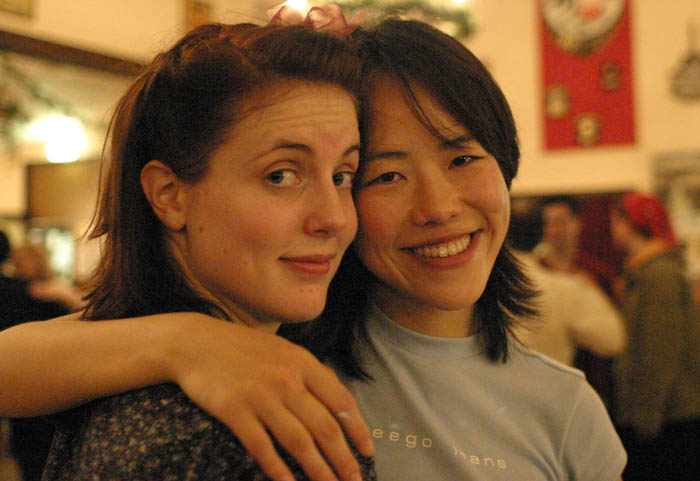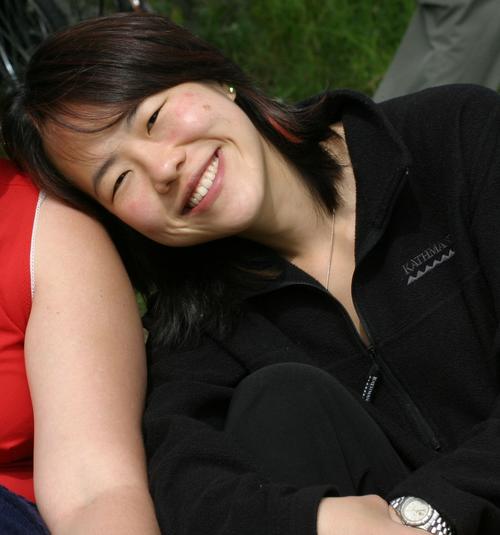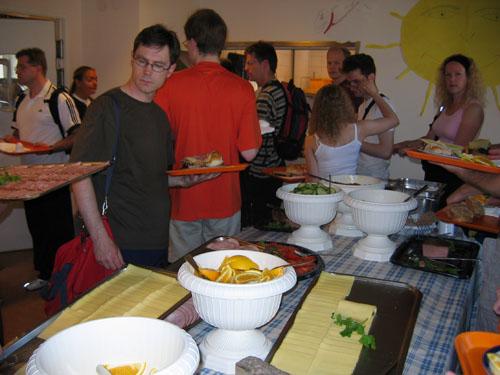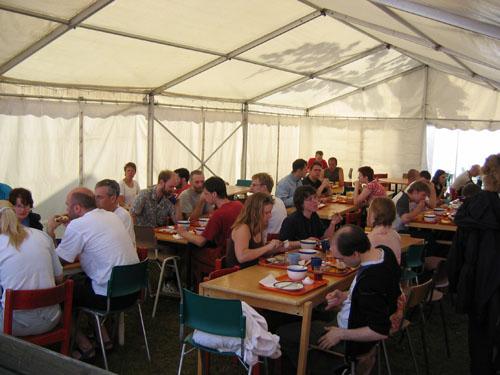Just watching some clips of Manu (one of my absolute favourite lindy hop leads – in that I want to be him) here and got to thinking: pro Jack and Jill comps (where you’re randomly matched with a partner and have to dance to music you don’t choose) are just like theatre sports. Well, when Manu and Sylvia do it, anyway…
This is how I feel about Jack and Jill comps – they’re like a fun party game. This is one of the reasons I don’t get nervous with J&J comps (or other dance performances, really): it’s a game. Even if it’s just you performing, it’s still a game, because the audience has a role to play as well – they have to be The Audience. I wonder how much of this approach to performance and competition is a result of my research and developing ideas about the roles of performers and audiences in swing – and how both are ‘performances’?
I have moments of nerves – literally moments – but I don’t get nervous about performances or comps. Same as I don’t get nervous when I’m tutoring or lecturing. I just enjoy it so much, I don’t have time to be nervous.
It reminds me of something that Crinks said the other night. She mentioned a discussion she’d had with some other dancers (people with lots of performance experience) about getting nervous. Someone said ‘I wish I didn’t get nervous’ or something similar, and the other person said ‘I wish I still did – I don’t any more. And the nerves were part of what made it exciting. Now it’s just pedestrian’ (I am paraphrasing majorly here).
It’s funny, because I find that I do a better job if I’m not nervous, and I can relax and get on with focussing on the other stuff and doing a better job. Especially in the case of teaching or lecturing or giving papers: if I’m nervous, I can’t concentrate on the questions people ask, and I don’t do the best job I could.
So when I watched Manu and Sylvia in that J&J, all relaxed and having fun, I thought ‘yes, this is what it’s supposed to be like – fun. And a game’. Space Jump.
Category Archives: lindy hop and other dances
Recent Lindy Hop adventures
I’ve just seen some clips from the Ultimate Lindy Hop Showdown competition this year (on a french site whose name I can’t remember, sorry) and I’ve noticed some interesting tropes.
What’s the ULHS?
The ULHS is one of the most well-respected lindy competitions in the swinguverse. The emphasis is on hardcore dancing, with a relaxed attitude. Sure, Hellzapoppin’ is still the lindy hop competition, but the ULHS is less about choreography and schmaltz than painful comps like the ALHC (american lindy hop comp/championships?) or the Australian Jitterbug Champs.
A word on lindy comps
I’m not a big fan of comps: I’m all about social dancing. But I also recognise the role comps can play in a dance community. They galvanise dancers, getting them keen and working on dance in a serious way. This of course brings up their dancing ability level, and setting new standards in the community.
The obvious draw-back is related to the type of competition: the VRRDA (victorian rock n roll dance association) comps which obsessed Melbourne dancers for ages about 4 years ago are all about the worst aspects of competitive dancing: 100% tacky, schmaltzy, choreographed rubbish (which is pleasurable, but in a different way of course); the AJC where the organisers would enter their own competition (it took 2 years for them to realise how unethical this was): what kind of cultural example is being set there? And of course, Dancesport: the name says it all.
So what did I notice about ULHS?
everything oldskool is nuskool
This is the age of the first wave lindy hop… or second wave.
The kids are getting hardcore into their old clips. THANK GOD! This has led to some scary second-rate imitations further down the line, but the first rank dancers are doing some seriously awesome shit.
crazy = good
This warms my heart (what with being a crazy dancer by trade).
20s solo charleston is still cooking along
Yay. One day Melbourne will get into it in a big way.
Melbourne is still trying to be the USA, dance wise
Sure, there are good reasons to be inspired by the American example, but imitation… hm. It’s kind of a dilemma, because lindy hop is all about imitation – historical recreation. But my concern is with dancers immitating recreationists, rather than dancers getting out there and exploring the original footage.
How to dress
On the other hand, one thing I did think while watching the clips was how appropriate it is to wear contemporary dress while swing dancing. It’s like Shakespeare: it’s always set in the ‘current day’. So wearing contemporary clothes is very appropriate (especially as we are always ‘wearing’ our contemporary cultural ‘clothes’ when we dance or move or speak or write or….).
It’s a dilemma: everything old is new again, and yet everything new is also very appropriate.
One thing I noted (on this point) was the way performers would wear ‘old’ clothes (vintage or recreationist) for performances, and then ‘new’ clothes when they competed. It strikes me as an example of framing and ‘performing’ identity. When performing in formal Performances, they’re putting on an historic identity, framing their dancing performance as recreation. When they perform in competitions, they’re performing their own identities – their own selves (or another of their own selves?), so they wear their ‘own’ clothes. And of course, the two identities and performances aren’t seperate: they are intended to be read intertextually. So when we see Frida in her crazy modern young person clothes, we are still reading her in reference to her historical recreationist work in the Silver Shadows, and in the Hot Shots. This historical cross-referencing serves to authenticate and justify her authority as a dancer, and her status as a ‘good’ dancer.
And just one more point:
Vaudville and lindy hop
I need to get a hold of Henry Jenkins’ book on early musical cinema (1930s). He discusses the vaudville aesthetic and the shift to cinematic narrative in these films. This issue has caught my interest as well, in reference to swing dancers. The ULHS reinforced the vaudvillian aspect of swing dancing: it’s a matter of sitting down to watch a series of individual ‘spectacles’ which we read intertextually. Just as with vaudville theatre, there’s room for audience participation: being an audience is ‘active’.
I’ve been thinking about vaudville and shows like Dancing with the Stars a bit lately, and how we really like it, as audiences. I’d also hazard a speculation that vaudville didn’t really go away – telly is all about pieces of ‘spectacle’ which we put together in a larger viewing ‘whole’. This of course echoes some of the 80s (or was it 90s?) stuff on telly and the ‘glance’ and ‘segments’ of image/narrative/viewing. It emphasises the ‘active’ viewer. Which is what swing dancers are all about: active viewing. Active spectatorship.
dance talk
i’m a bit inspired, dance-wise. it was really nice to get some decent teaching, somewhere outside of angsty old melbourne. it was also nice to meet so many interesting people from all over the world – that was the best thing about herrang.
but i’m totally into leading now – not particularly interested in following. maybe i would be if there’d been any guys in herrang who’d done classes and were interested in trying stuff with me. but doris and i are cooking, and corinne is always up to try things out. so it’s girl on girl action at the moment: i am damn lucky to be able to dance with these two superior follows. corinne leads a bit, and doris is interested: soon we will all be all-leading, all-following chicks.
rawk on.
i am obsessed with weight transfer and leading and following with your centre. this obsession was only fueled by the amazing max at the gym (who does my programs and assesments), who’s taken up aerial work. we had an excited talk about centres the other week: much enthusiastic realisations about how bodies move in space.
max rawks.
a quick gym note: i am doing a hardcore upper-body and core-strengthening program. so my arms and shoulders ache, my abs ache and i’m getting much more control, centre-wise.
max rocks.
and i am getting a two-pack. if i had less of a jelly belly, i might have a three or four pack. but i do, so i don’t. or if i do, i can’t see it.
i really like being strong.
i’d like to be fitter, but i just can’t hack that boring, dull as dogshit cardio work… aerobics totally sucks.
it’s a sad, sad day when you’re eating instant noodles for breakfast
but it can’t be helped. my first night of proper dancing since i’ve been back (where i dance like a nut all night) and i wake up feeling a little ill. now, i’ve been dealing with herrang cold remnants since i arrived home last thursday, but it seems the IT nerd version of the cold which laid The Squeeze low has decided to take up residence in moi. sick again. so i’m feeling tired and rough and a little disappointed in my immune system. i thought we were a team.
at any rate, despite my attempts to eat only sandwiches since i arrived home, there is no decent bread in the house. the only alternative for sick-girl was obviously instant noodles. and i think the milk has gone off.
sigh.
meanwhile, the handyman (who i quite like) is wacking things in another room, attending to 2 of the 10 or so items on our list of ‘fix it now you bastards’ things. a list we sent to the real estate agent before i left (we’re talking at least 7 weeks ago). only now, since i’ve been home and threatened to kick arse have they done anything about this list. a plumber is promised, but i doubt we’ll see him any time soon.
meanwhile, the lease is up, so we’re living on borrowed time and with little room to apply pressure to our arsehole landlord. we are trying to decide whether or not we should move. unfortuntately, though, areshole landlords dominate our price bracket, and while we pay too much rent here, it’s still cheaper to stay than to pay for all the moving crap.
ah, renting. how wonderful it is.
first night dancing
Last night we went to the Austrian club to see JW. My first night dancing since i’ve been back (and it’s been about a week since i last danced – feels like a couple of days, though, owing to the weirdo travel thing). The Squeeze brought his excellent digital camera and took some wonderful photos of the band. i had a play and took some nice photos of my friends. they’re a bit grainy because it was quite dark there, the shutter speed wasn’t quite quick enough (i think – i don’t really know about this stuff), i don’t use flash (because people look horrid and washed out, though The Squeeze has introduced me to the notion of fill flash. hm.) and they were a bit far away.
This is a picture of doris and corinne. aren’t they pretty? this is an edited version (i cropped for framing). i’m still learning, so be kind.
also, i’m having some troubles with mt uploading my files. so the link to the popup might be broken. check the archive for a better copy if you want to save a copy. please keep in mind that these are photos i’ve taken myself, and you should (if you’re any sort of decent person) credit me. if you want to use any of these photos in your own publications (including websites) please get my permission or at least credit me and link to my site.
ta.
flying home
There’s something strange about being the only person in a block of apartments after spending two weeks in the constant company of at least 200 people. Especially when those 200 people are almost always in constant physical contact with each other.
The second camp – Camp Savoy – is over, and I’m taking an extra night in the student housing to recover before I fly out of Heathrow tomorrow night. The weather has been utterly wonderful: very warm, very sunny. This could be a university campus anywhere in Australia. Though the food marks it as singularly British. Otherwise, there are very few English accents about – this being a university campus and all – and I’m really quite enjoying doodling about on my own.
Could do with a bit of company, but still
how could I complain about such a long, glorious evening with such wonderful warmth and cooling breeze? And after all this sitting about on the hilly lawn under the student accommodation, reading The Guardian (which I’ve missed) and beginning to think again, I’ve a lovely clean, dry bed with sheets and no early morning missions ahead of me.
The last two weeks have been incredibly intense. Herrang was the perfect exercise in indoctrination: intensely, physically demanding days with round the clock dancing, where doing a beginners class in aerials at 12midnight (midday Herrang time) seemed perfectly logical and plain black tea was a precious commodity to be traded illicitly and only between friends. I have surely joined a cult, and am in dire need of deprogramming.
Living with constant physical exhaustion, sleep deficiency and irregular meals have taken their toll and my health has once again dropped. The Herrang bug has been hanging about in my sinuses since late last week, and pushed me into naps every afternoon. Expensive classes with world-class lindy hop egos be-damned. There’s rest and recuperation to be done. My lungs are beginning to fill and the Horrid Cough has returned. I predict much wailing and gnashing of teeth when the plane takes off.
Flying with feet as sore and mangled and swollen as mine were last week resulted in a pain so spectacular I would have bawled like a baby if I’d not been so tired I fell immediately into a sleep that defied even take off. While the effects of constant dancing haven’t quite worn off – there are some disturbingly numb spots on my toes and recurring bouts of pins and needles – I’m hoping these couple of days of rest will make flying a bit more comfortable. I’ve regained some higher brain function and have managed to stay awake all day, though I’ll probably find myself all awake and twitchy at about 1am, looking for some dance floor action. But for now, it’s 8:34pm and I’ve not napped today. I must be getting better. There’s also been no dancing, and I’m not sure I’m ready for that. Over two weeks of dancing every day for at least eight hours is kind of addictive. I’m in endorphin withdrawal, I’m sure. How will I cope with Melbourne’s dark and horrible winter?
Pft. It’s such a lovely, warm evening, it’s hard to imagine Melbourne’s crap weather. For now, while I’ve borrowed from Lionel Hampton, I think Miles Davis is the only possible musical alternative for this evening.
laundry report
My backpack full of clean laundry, care of Eva’s washing machine and a night break between camps, is now more a mixed bag. I am down to the non-dancing underwear (where the dancing underwear seems to have largely disappeared: I’m sure I’ve lost knickers in the Herrang laundry. Despite Grace’s best efforts) and once again wishing I’d brought some thai fisherman’s pants with me. But who’d have thought loose, cotton nappy-inspired trousers would be the perfect garment for a dance camp in Europe? Note to self for future reference, I guess.
The wedding clothes proved just as irritating as I’d thought: sure, I could have dressed up for the blues nights at Herrang (one can never be over dressed for blues night), but then I’d not have felt as comfortable as I did. Ah well.
I’m going to have to hunt for something clean for flying in. Something I can bear to wear for 24 hours straight
Future Herrang visits: more trousers. More loose, comfy cotton trousers. More thai fisherman pants. Ten tshirts is enough. Bring bike pants to manage inevitable Chafing Issues. Never too many pairs of underwear or socks. Bring only machine-washable, quick-drying clothes. Care not for crinkles. Swimming costume an essential for shy-bies (not that I had the opportunity to see if I was shy). Sheets. Say yes to a sheet. Hat. Sarong – another essential.
How will I manage Melbourne’s winter weather and fashion requirements? Especially now I’m at least a size smaller than I was before I left. Goddamn this super-responsive metabolism. It adores exercise. And dancing truly is the best exercise there is.
brit hop revisited
I subsequently met the young fella from London who designed the London Lindy Exchange (LLX) Brit Hop tshirts. He was in Herrang. He was young, cute and a lovely dancer. I know it’s wrong to be patronise, and I do try not to. But he was.
And it was a brit pop joke.
Eeeexcellent.
doris
eating in herrang
here we are lining up for breakfast. things are moving slow…. note the cheese. cheese is big with the swedes. we eat a lot of crackers as well. the food is bloody good.
and here we are eating in the tent.
the tents are important features on the herrang landscape. we eat in them, we learn in them, we practice in them. meals are my favourite thing – good food and lots of good company.




